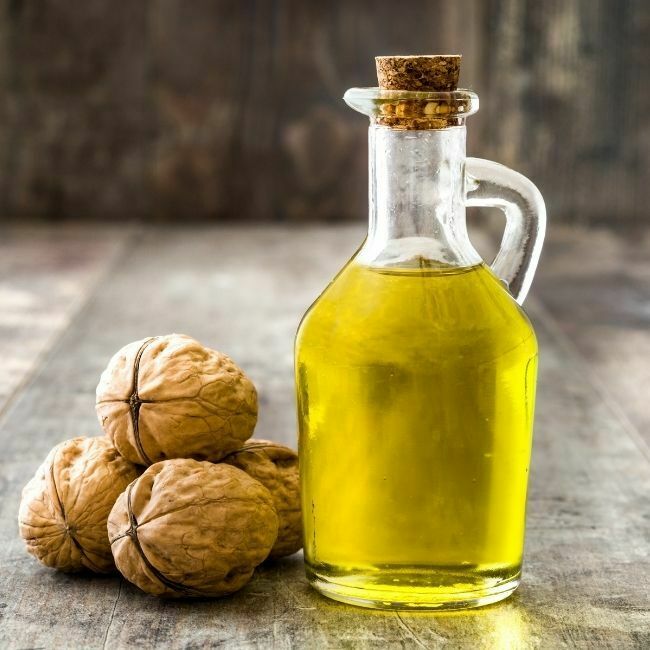Recently updated on: December 14th, 2022
Walnut (Juglans regia L.) is a source of many other valuable ingredients, including walnut oil derived from the fruit flesh, which is used not only in cooking, but in cosmetics as well. Walnut leaves and green shells of unripe fruits also have therapeutic properties: anti-bacterial, anti-inflammatory, antidiarrheal and anti-hemorrhagic.
Walnut oil – nomenclature and description of properties
Walnut oil is also called nut oil. Noteworthy, this name is reserved only for cold-pressed oil derived from walnut fruit. Therefore, it is incorrect to use the term “nut oil” with reference to coconut, peanut or hazelnut oil.

Walnut oil
Food-and cosmetic-grade walnut oil is high in omega-3 fatty acids, protein, antioxidants, plant sterols, magnesium, copper, and vitamins A and D.
Cold-pressed nut oil is characterized by a very high contents of unsaturated fatty acids (UFAs), in particular omega-6 (linoleic acid 52.92%), omega-3 (α-linolenic acid 13.23%), and omega-9 (oleic acid 17.62%). It also contains saturated acids: palmitic acid (7.71%) and stearic acid (2.79%), as well as γ-tocopherol, a derivative of vitamin E (53.97 mg/100g).
Properties of walnut oil
Thanks to the high contents of the compounds listed above, walnut oil has a range of beneficial properties used in cosmetic care products. The fatty acids, in particular the linoleic acid and the α-linolenic acid, improve lipids management in the epidermis, protect against transepidermal water loss and normalize skin metabolism. Importantly, this is how they provide moisture to dry skin, as well as unblock pores, improve sebaceous gland regulation and reduce the number of blackheads in persons with oily, acne-prone skin.
The moisturizing effects of nut oil is also ensured by tocopherol. Alike unsaturated fatty acids, this compound integrates into lipid structures of cell membranes and the stratum corneum of the skin, inhibiting the penetration of harmful substances and limiting water loss. Furthermore, tocopherol is a very powerful antioxidant, slowing down aging of the skin and protecting it against UV radiation.
Walnut oil – its use in cosmetic products
Nut oil may be used both in the form of hair or skin oil, as well as serve as a base for production of cosmetic products,
in which it is an ingredient recommended particularly for persons with problem and acne-prone skin, because it does not block pores and additionally helps eliminate persistent pimples, eczemas and imperfections. At the same, it moisturizes the skin, improves its flexibility and supports the regeneration of damaged epidermis, which makes it also a good choice for dry skin.
On its own, nut oil may also be used for hair oiling; it’s particularly effective on highly porous hair. Moreover, thanks to its nice smell and beneficial properties for the skin, walnut oil is popular as a massage oil.
Bibliography:
- Krajewska M., Zdybel B., Andrejko M. i wsp. (2017). Właściwości Chemiczne Wybranych Olejów Tłoczonych na Zimno. Acta Agroph., 24(4): 579-590. http://www.acta-agrophysica.org/Chemical-propertis-of-selected-cold-pressed-oils,105077,0,2.html
- Zielińska A., Nowak I. (2014). Kwasy tłuszczowe w olejach roślinnych i ich znaczenie w kosmetyce. Chemik, 68(2): 103-110. https://yadda.icm.edu.pl/baztech/element/bwmeta1.element.baztech-e27797dd-5d78-4234-ad19-d9e55485a098/c/Zielinska.pdf
- https://www.kosmopedia.org/encyklopedia/tocopherol/
- https://oliwka24.pl/olej-z-orzechow-wloskich/


